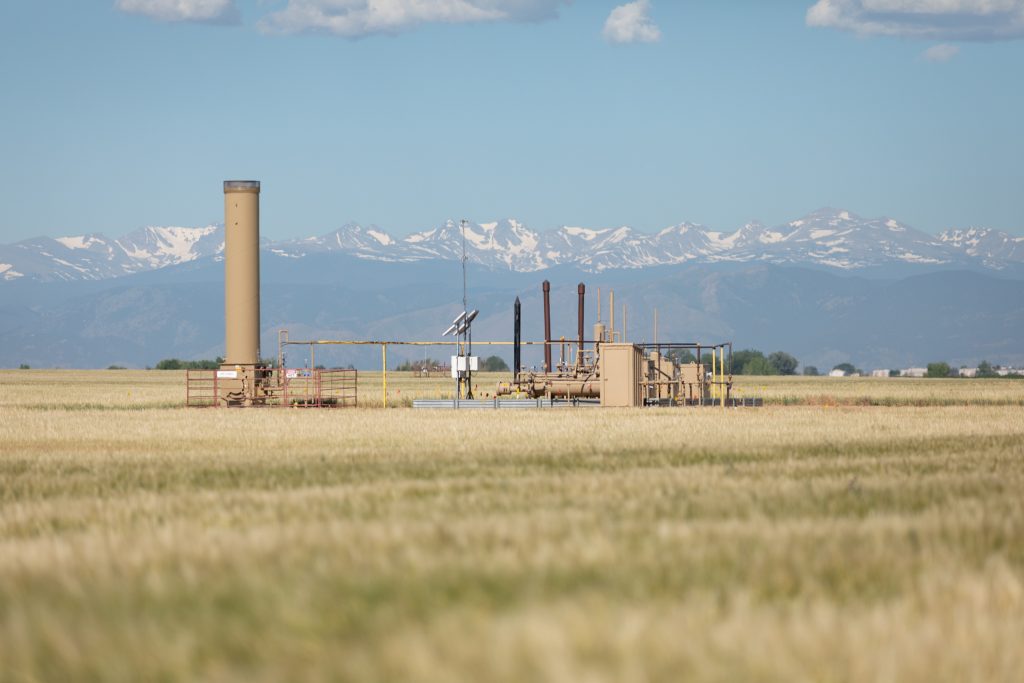
Fossil fuel extraction infrastructure is pictured northeast of Longmont, Colo., on June 24, 2020. (Andy Bosselman for Colorado Newsline)
Colorado air quality regulators will consider a proposal early next year for stricter rules on hazardous emissions from the oil and gas industry, as the state continues to struggle to rein in its long-running ozone pollution problem.
The Colorado Air Quality Control Commission voted unanimously last week to move forward with the changes to state air quality rules proposed by the Air Pollution Control Division, an arm of the Colorado Department of Public Health and Environment. The so-called Regulation Number 7 revisions will be taken up by the AQCC at its monthly hearing in February.
The new rules would require the use of improved equipment for preventing and detecting leaks at thousands of oil and gas facilities across the state, with a particular focus on a nine-county region known as the Denver Metro/North Front Range Nonattainment Area, which has for decades been out of compliance with Environmental Protection Agency standards for ozone, a hazardous air pollutant.
GET THE MORNING HEADLINES.
Ozone is formed by a chemical reaction between sunlight and certain “precursor” pollutants, including nitrogen oxides and volatile organic compounds, or VOCs. Top local sources of ozone precursors include oil and gas operations, motor vehicles and lawn and garden equipment.
The state’s proposed rule changes target emissions of both VOCs and methane, a potent greenhouse gas, from oil and gas production sites, compressor stations and processing plants. They would require the use of zero-emission pneumatic controllers, devices that operators use to automate the flow of fossil fuel products at industry facilities. Regulators say there are over 94,000 pneumatic controllers in use at 5,697 facilities statewide, and many of them emit gases by accident or design.
“While these individual devices contribute only a small amount of methane and VOC emissions individually, together it’s a very large quantity,” said Jeremy Schuster, an APCD regulator, during a Nov. 20 hearing on the proposed rules.
Other changes made by the new rules include strengthening requirements for optical imaging technology used to detect leaks at larger facilities, as well as new requirements for collecting data during early production phases at individual drilling sites.
While the proposed changes are partially modeled on new federal rules on oil and gas operations, state staff told AQCC commissioners that the repeal of those rules by the incoming Trump administration wouldn’t affect state-level enforcement.
“The commission has authority to adopt requirements like these, even without a directive from EPA,” said the APCD’s Leah Martland. “It’s something we’re certainly tracking, to see what happens on the federal level, but that does not preclude you from adopting these proposed revisions.”
If adopted by the AQCC next year, the new standards for pneumatic devices would be phased in, beginning with facilities located within the ozone nonattainment area, which would have to comply by 2027. Kirsten Schatz, a clean air advocate with the Colorado Public Interest Research Group, said in a statement that the improved technology is “readily available.”
“The state should move to require zero-emitting pneumatic devices on oil and gas equipment statewide as quickly as possible,” said Schatz. “Operators already use zero-emitting pneumatic devices on newly-installed equipment; now it’s time to stop preventable releases of harmful pollution from existing equipment as well. Our health and quality of life demand no less.”
YOU MAKE OUR WORK POSSIBLE.

